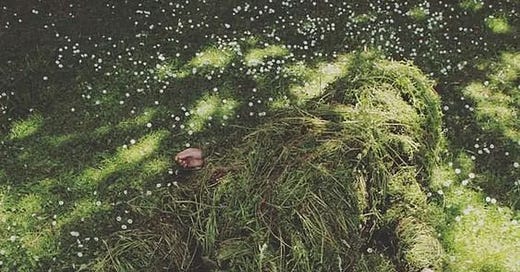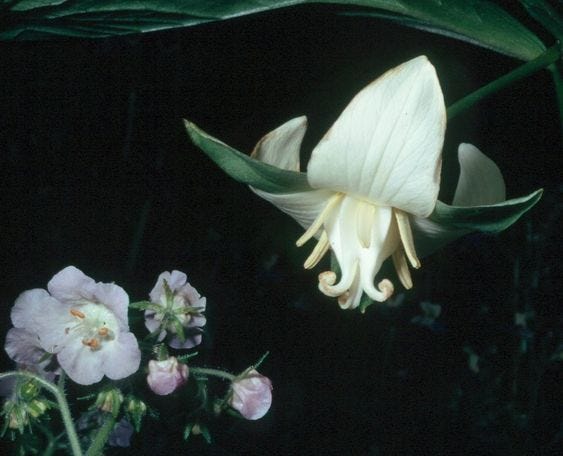Some announcements at the end of the essay 🌱
Mountains are waves that have surrendered to stillness. The result of a collision that grows with time, slowly, at its own pace. As they surrender to their own rhythm, life grows around and inside of them. They make me envious sometimes, these wise giants, because of how little they try to control their destiny.
Every week, I plan to write an essay on a certain topic and then the universe throws a curveball at me, this week a very big one, and I end up writing about something else. I was meant to write about Joy, but I’m now writing about surrender.
I have encountered what I recognise as true surrender twice in my life and, on both occasions, it was an antidote to fear. On the first occasion, I was on a plane with the strongest turbulence that I had ever witnessed, even the flight attendants were scared. After a moment of pure fear, I remember accepting the lack of control I had over my own life at the moment, and felt an incredible sense of relief. On the second occasion I had night terrors (it was the first and last time thankfully), and I remember feeling my body trying to escape danger but completely unable to move. I remember thinking “Vi you can’t do much right now, so just let go”. The minute I relinquished control, I woke up and was able to move. Both were two of the most relieving moments in my life.
Today, I feel like I have swallowed the fears of others and made them mine. Tried to control outcomes in imaginary places where I had never been. What do you do when your biggest fear comes knocking on your door? You open up, you give yourself over, surrender and pray for the courage of acceptance, and you sit in the discomfort of it all.
But what does surrender look like? What is its texture? What role has it had in my personal life? And what role does it have collectively?
The first time I was exposed to the idea of surrender was playing tug of war in the courtyard with my school friends: boys against girls (millennial youth!). When the boys were pulling too hard and getting aggressive, the girls surrendered. Often we would get teased by them for being weak.
Weakness held hands with surrender as I walked into my teenage years.
This vision got stronger as I began to observe the narratives around surrender in movies and media. I started to notice that most kissing scenes in movies portrayed men insisting, and imposing their (usually larger) bodies on a woman — here is a good example- and finally, the woman surrendering to their seduction.
The more I observed, the more I recognised how surrender played different roles in male and female narratives. In the male narrative, men would often endure an incredibly harrowing fight and then choose surrender instead of death — a good example here. In a female narrative women surrendered to the forceful approaches of men, at first resisting, but then surrendering to “love”.
This idea of surrender was perpetuated in the narrative of conquest. Growing up I was often advised that I should “play hard to get” if I wanted to attract boys, or even get a job. It seemed to me that for a man surrender meant defeat, whilst for a woman it often meant avoiding a dangerous situation or further violence.
I grew up exposed to an idea of surrender that was biased. Today, as I face the difficulties that human life entails, as I worry about my body, I know that Surrender has no gender, it doesn’t even have a narrative, we try to give it a name and a reason because the reality is that it is one of the most challenging things we can do. Surrender is simply what comes when we relinquish control, the thing that keeps us prisoners of the mind. Surrender is deeply human, it is queer, it is malleable, and it lives in a quiet place inside our bodies, one which we long to become familiar with.
The word comes from the Old French sur, meaning over, and rendre, meaning to give up, to relinquish. To give over.
Interestingly, the reflexive of surrender is “to give oneself over”, and Natalie Khun suggested to me that we read this slowly. To. give. one. self. over. Give up one of your selves, and relinquish the perpetual dance with control.
In a world that is defined by hierarchies of power and linear structures, this type of surrender is rooted in introspection and exploration, the closest thing to the unknown. I particularly like how Audre Lorde describes this deeply female and spiritual plane in her essay Uses of the Erotic: “firmly rooted in the power of our unexpressed or unrecognized feeling.” Any step, no matter how small, towards unlearning, and any action towards reclaiming our own narratives brings us closer to not fearing what is next and thus surrendering to it.
This approach to surrender comes from the interior, the poetic and the beautiful, and the celebration of poetry is radically political in our society. As Audre Lorde said, “Poetry is not a luxury. It is a vital necessity of our experience for living structures defined by profit, by linear power, by institutional dehumanization, our feelings were not meant to survive” she continues.
Maria Popova from Brain Pickings depicts sensuous (of the senses) surrender perfectly when she says: “Paradoxical as it may sound, to stop resisting that which we cannot control is the only choice we have, but it is also one we must actively make in order to transcend our limits”. So, in a way, reclaiming the narrative of surrender is a way to transcend society’s limits; it is politically relevant.
I envision myself on the earth, still, not moving or trying to do anything, and slowly watching as the earth grows around me, as insects make motorways of my scars, as the wind makes channels of my wrinkles. Surrender is not a place of inaction, it is fertile soil where action can grow, it is not an excuse to become passive, but a moment of necessary release needed to begin again.
Much love,
V
Find an embodiment exploration of surrender below, free for all readers this week 🌻
Ritual/Embodied Exploration:
Inspired by an exercise proposed to me by Somatic therapist Francesca Mariano:
What you need: a pen, a piece of paper, your body.
With this question in mind: What does surrender look like?
Shake your body for the duration of this song
Then for 2 minutes free draw on a piece of paper. It can be lines, circles, or unknown shapes, let your hand and body guide you.
Put your drawing on a wall (or if you want do this with another person), and begin dancing its shapes. Do this for 10 minutes (explore all the dances and movements possible).
If you feel like it, journal how you feel.
Join the Ecological Approach to Masculinity Workshop (Starting 26th November)
In a world where the narrative of masculinity is often fragmented, misunderstood, or stagnant, the Ecological Approach to Masculinities online workshop offers a transformative space for individuals to engage in deep dialogue, introspection, and creative exploration through ecological and mythopoetic lenses. Delving into ecological, political, historical, sociocultural, and mythopoetic lenses, we aim to rewild and reshape masculinity narratives. Our four-session workshop infuses the personal with the collective and the interpersonal with the intra-personal.
When? Four Sundays - November 26, December 3, December 10, and December 17, at 6 pm CET / 11 am EST.
Each session lasts 1.5 hours.
Tickets:
Individual: $160
Buddy Discount (2 participants): $220
Special Offer: 20% off for WAVES paying subscribers.
If you are in a vulnerable economic situation but are still willing to commit, please email me at virginia.vigliar@gmail.com and I will try to accommodate your needs.
Read my Roots of Sisterhood essay for Atmos
Narrative Antidotes on We Walk the Earth Podcast
Read my Space Feminism essay for Topia Magazine
Read The Art Corner - weaving narratives with creatives
Find me on Instagram








